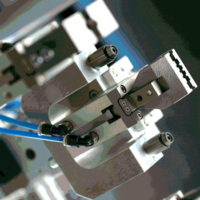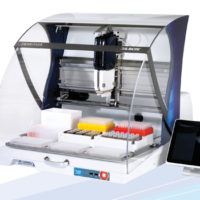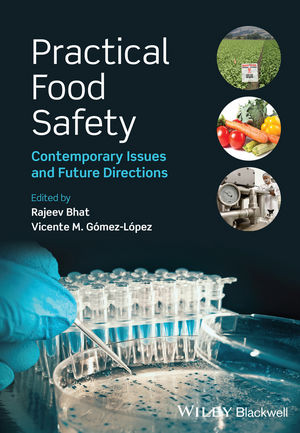Utilization of Automation in the Contemporary Food Testing Laboratory

Laboratories are increasingly utilizing automation for a variety of tasks. In clinical and pharmaceutical testing labs, robotic systems routinely perform numerous operations, including sample transport within a facility, sample preparation steps, and automated data processing and bulk-liquid handling. These applications are poised for movement into the food analytical chemistry space. Utilizing lab automation will provide multiple benefits enabling food testing facilities to deliver the highest-quality data in a range of areas, such as nutritional analysis and food safety.
Lab automation is a broad term that can be applied to numerous laboratory activities. In this article, automation will be defined as any process where human interaction is replaced by inanimate, automated procedures. These automated steps can be performed via robotic or mechanized components and systems, or they may be computer- and software-based applications. The common principle is that the actions run without direct human involvement other than the initial setup of the method.
Benefits of Automation
Numerous benefits are consistently observed when automating laboratory activities. For example, method variability is reduced when the human element is replaced with lab instrumentation. A two- or threefold improvement in precision is common when a process is automated. Another positive aspect of applying automation is a reduction in labor costs. The automated lab can take on additional workloads without increasing staffing levels. Increased employee satisfaction is an ancillary benefit to this increase in lab efficiency. The lab staff is able to work on more impactful applications when the burden of repetitive activities is removed. An increase in lab throughput, with a corresponding decrease in analysis cycle time, is often seen with automation. Removing manual processes shortens overall analysis completion time. The utilization of automation typically reduces solvent volumes for the analysis compared with manual steps, which decreases the reagent and waste removal costs. Another tangible benefit is the reduction or elimination of contact with chemicals, which impacts the health and safety of lab personnel.
Automation Challenges in the Food Testing Lab
One hurdle in applying automation in the food testing lab is the wide variety of sample sizes and forms found in this segment. Complex bars and meal replacement powders or concentrates, frozen food, beverages, raw produce and meat products all require different mechanisms to prepare and subsample prior to analysis. Raw materials have a similar large range of forms, from intact ingredients to fine powders. In contrast, the clinical and pharmaceutical industries have a substantially less diverse assortment of forms. This difference makes the application of lab automation much simpler in a non-food analysis setting.
Another significant challenge with automating food testing methods is the uneven distribution of target analytes (heterogeneity), which often requires large sample sizes to achieve adequate method precision. Natural products have an inherently variable distribution of compounds throughout the bulk sample, which makes obtaining a representative sample difficult. The most common strategy to combat this challenge is to utilize a relatively large sample size. Sampling in the 10- to 50-gram range is typical for food testing methods to ensure the subsample undergoing the method steps represents the content in the entire lot of material. One way to overcome the heterogeneity problem is to create a more thoroughly processed and blended sample, for example, by using cryogenic milling. Effort expended on the sample preparation step to create a fully homogenized product means less initial sample is required (sample sizes in the hundreds of milligrams are typical) and the automation tools can be applied more effectively. This miniaturizing of sample size also opens the possibility of utilizing smaller final sample volumes, including the 96- or 384-well plate formats, further increasing the efficiency of liquid-handling applications.
These barriers do not prohibit the use of lab automation in the food testing space. The challenges require the thoughtful design of equipment and processes to ensure the automated solutions can be applied with minimal impact on the final results.
Considerations in Developing an Automation Plan
The ideal state is end-to-end, seamlessly integrated automation equipment. In reality, only certain aspects of the lab processes are “automatable” or make economic sense to automate. Several factors must be taken into account when creating an automation solution.
The volume of the repetitive event is an important factor in determining whether an activity should be automated. An action that is performed occasionally (only a couple of times per day) is generally less important to automate than a highly repetitive task. When formulating the list of lab steps to be automated, priority should be given to the highest-volume events. The decision threshold to apply an automation solution is not a firm number but highly individualized for each laboratory. When assessing the cost-benefit for applying an automated solution, the lab will preferentially select the most commonly performed activities to gain the greatest impact for their applications.
Often, identical method steps are applied across various assays. Leveraging the same automation equipment on multiple methods can increase efficiency, especially in smaller labs. Although time must be invested in switching solvents, labware and/or consumables for instruments shared by multiple applications, the overall positive benefits outweigh the additional work in the changeover. The ideal case is to have miscible solvents that can easily be sequentially flushed, without the added time and cost of intermediate washing, and to standardize labware utilized on the automated robotics.
Another factor to consider when investigating automation is the difficulty of automating a specific step. Robotic instruments can be created for any routine task; however, some activities are more difficult than others to replicate with automated equipment. This area will be further explored in the discussion of food lab steps that are more readily automatable and ones that are less amenable to automation.
Automation Amenable to the Food Testing Lab
The most typical automation application applied in the contemporary food testing laboratory is liquid handling. This area encompasses a broad range of method steps with one common factor: the step is being performed on samples in solution. This type of automation is most closely aligned with the equipment applied to other testing industries, specifically in the clinical and pharmaceutical arenas. Examples of steps that have many commercially available automation solutions are dilution, derivatization, pH adjustment, liquid extraction, mixing/stirring, centrifugation and evaporation. The instruments used to perform these steps can range from simple hand-held or small bench-top devices to large robotic systems capable of performing multiple steps simultaneously. In this same category are instruments built for specific applications, such as automation of fiber method steps. This application of automating method steps is often the most impactful, and multiple methods can easily be bundled to increase the efficiency gains.
Another step that can be easily automated is the data processing to obtain the final measured result. Most lab equipment is controlled via dedicated computer software. Even stand-alone systems typically have data outputs that allow transfer of results from the instrument directly to an electronic notebook, database or laboratory information management system. Automated data transfer from chromatography and spectroscopy software and other lab equipment, like balances, water activity meters and calorimeters, can increase lab efficiency with little capital investment.
Among the most sophisticated data processing automation solutions is the programmed review and release of data. This type of automation allows the user to create a series of logical conditions for data. There are three possible outcomes of the automatic data review. The results can meet the conditions, resulting in the approval and release of the data. The data can meet the critical criteria but fail other qualifiers, which flags the testing for additional review. The third possibility is that the results fail critical conditions, which results in the automatic rejection of the data. This type of automation solution eliminates the distraction of clean, unambiguous data, allowing the data reviewer to focus on the most uncertain data that require a more thorough review. Automated data review does carry some risk and requires substantial initial validation along with periodic review to ensure that no data are released incorrectly.
Similar to data review automation is the logic available within chromatography and spectroscopy applications to perform tasks based on the outcome of the specified tests. System suitability requirements, such as retention time or area variability and spike recovery, can be added to the automated method. These criteria will be applied after the appropriate injection or samples analysis has been completed. Actions to be performed based on the results can be defined within the software and applied automatically. Options for next steps can include reinjection, stop the run and flush the system, or notify the chemist via email or text message. These solutions greatly increase the method uptime and reduce manual interaction with the testing instrumentation.
Another type of advanced data processing automation is the programmed fraction collection of a high-performance liquid chromatography separation. In this application, a set of criteria is created to mark when to begin and stop collecting the fraction. This fraction can be immediately sent to an orthogonal separation, or it can be stored for further analytical steps to be performed.
Difficult-to-Automate Activities
Some activities do not lend themselves easily to automation. One area that is difficult to automate in the food testing lab is sample weighing. Several instruments are available that can accurately weigh liquid and powdered samples. Food matrices encompass a wide range of forms. Solids, semisolids, suspensions and liquids are all found within the food sample space. A lab that focuses on one type of food form (all suspensions, for example) will find automating sample weighing far easier than the lab that handles a wide variety of these sample categories. Sample weighing is also difficult in the food testing lab, as most assays do not share a common weighing container. Ash crucibles, moisture tins, beakers, centrifuge tubes and volumetric flasks are typically employed for sample weighing, depending on the method needs. The effort involved in programing each type of container makes the sample-weighing process ill suited for automation.
Sample transport also does not lend itself easily to automation. Automating transport of samples to different areas of the lab is difficult due to the wide range of product forms, the great variety of package sizes and the large number of storage conditions, from ambient temperature to cryogenic freezing. Even after a sample has been prepared for analysis by grinding or a subsample has been transferred to an appropriate container, there are still a significant number of sample forms and storage conditions that make the application of sample transport automation ineffectual. Laboratories that can standardize sample containers and work in a narrow matrix range have the best opportunity to automate the transfer of samples within a facility.
Lab Automation—A Holistic Approach
Automation has the potential to transform the food testing lab by replacing outdated manual processes with instrumentation and software capable of improving method performance and increasing lab efficiency. While a fully automated food testing laboratory is not the current reality, there are several tasks that can be easily automated to decrease how much time lab employees spend conducting lab processes. Careful evaluation of the procedures employed within an individual lab can identify automation opportunities. After the selection of the automatable steps, a thoughtful design of how these solutions can work together should be undertaken. Even when adding automated solutions later, effective integration with existing instrumentation is a key objective. By developing a unified system of automation pieces, the lab can enjoy the maximum benefits.
Tom Vennard is manager of R&D and method development at Covance.
Looking for a reprint of this article?
From high-res PDFs to custom plaques, order your copy today!








